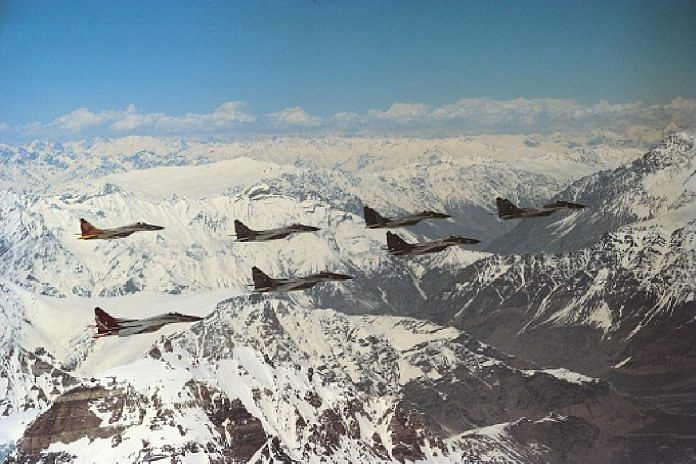New Delhi: The No. 28 Squadron of the Indian Air Force (IAF), nicknamed ‘The First Supersonic’, completed 60 years in service. In March 1963, the Squadron inducted the Soviet-era MiG-21s in Chandigarh which marked a turning point in the IAFs inventory — as they were its first supersonic fighters.
Significantly, India got the MiG-21s as a counter to Pakistan being given 12 F-104 Starfighter supersonic aircraft by the US. The Starfighter was the first supersonic aircraft in the Indian subcontinent.
On 16 October 1987, after over two decades since induction, the No. 28 Squadron transitioned from the MiG-21s to MiG-29s. Given their experience in inducting the MiG-21s, the squadron was responsible for inducting the MiG-29s.
“The No. 28 Squadron has a long and illustrious history in service with the IAF. It inducted two fine platforms into the service — MiG 21 and MiG 29,” Air Marshal Diptendu Choudhury (retd.), who served in the 28 Squadron with both MiG-21s and 29s, told ThePrint.
To honour 60 years of the No 28 squadron in service, Chief of Air Staff (CAS) Air Chief Marshal V.R. Chaudhari flew in a large force engagement exercise involving MiG-29 aircraft Thursday. Interestingly, the CAS commanded the No. 28 squadron from 2001 to 2003.
Also Read: Looking at procuring nearly 200 combat & utility helicopters, says Army chief at Aero India
The 1965 and 1971 wars
In both 1965 and 1971 India-Pakistan wars, the No. 28 Squadron and the MiG-21s played an important role in India’s success. During the 1965 Monsoon war, the squadron was central in conducting combat air patrol duties, explained former IAF officer Sameer Joshi.
Angad Singh, an aviation expert, said, “No 28 Squadron’s feedback from deploying the early MiG-21s in the 1965 war ensured that the Soviet Union added guns to subsequent variants.”
This development had major ramifications during the 1971 war.
As Choudhury explained, “No 28 carried out successful steep dive bombing attacks on the two Pakistani airfields of Tezgaon and Kurmitola during the 1971 war. They also played a major role in the attack on the Governor’s House in Dhaka, this led to the governor’s resignation and hastened Pakistan’s surrender.”
The 1971 war was the No. 28 Squadron’s greatest hour in its history with the IAF, added Singh.
MiG-21 induction & Soviet deal
While the geopolitics of the era and the need to match Pakistan’s Starfighters were central to acquiring MiG-21s from the Soviet Union, the linked incentives in the deal ensured India purchase the fighter.
The Soviet Union provided India with the most fiscally prudent deal through licensed production agreements in the purchase, which enabled India to produce MiG-21s at the Aircraft Division in Nasik.
The first commanding officer of the No 28 Squadron was then Wing Commander Dilbag Singh, who went on to become air chief. Further, the first batch of the Squadron under Dilbag Singh, trained near Tashkent in Kazakhstan prior to inducting the MiG-21s in March 1963.
Given its continued service in the IAF, reports suggest that India has manufactured over 800 variants of the MiG-21.
Also Read: HAL unveils design for new supersonic trainer, can aid IAF in modern combat training
Specs of MiG-21
The MiG-21 is essentially a fighter and interceptor aircraft. It was amongst the first to successfully combine both characteristics in one aircraft. In its early iterations, it was a lightweight, short-range fighter, that achieved a speed of Mach-2 (2,450 km/hour).
Development began in the 1950s in the Soviet Union, and it was supposed to be a successor to the subsonic MiG-17s and 19s. It has since been deployed by over 60 countries since its development in the 1950s.
Over the years, it has had multiple variants, these include the MiG-21 F, F-13, FL, PF, U, R, M, SM, and PF-13, amongst others. According to estimates, it is the most widely produced supersonic fighter aircraft.
Currently, the IAF still operates 4 squadrons of the MiG-21 which are supposed to be phased out by 2025.
(Edited by Anumeha Saxena)
Also Read: New barrel, extended range — India & US explore joint development of M777 howitzer variant






